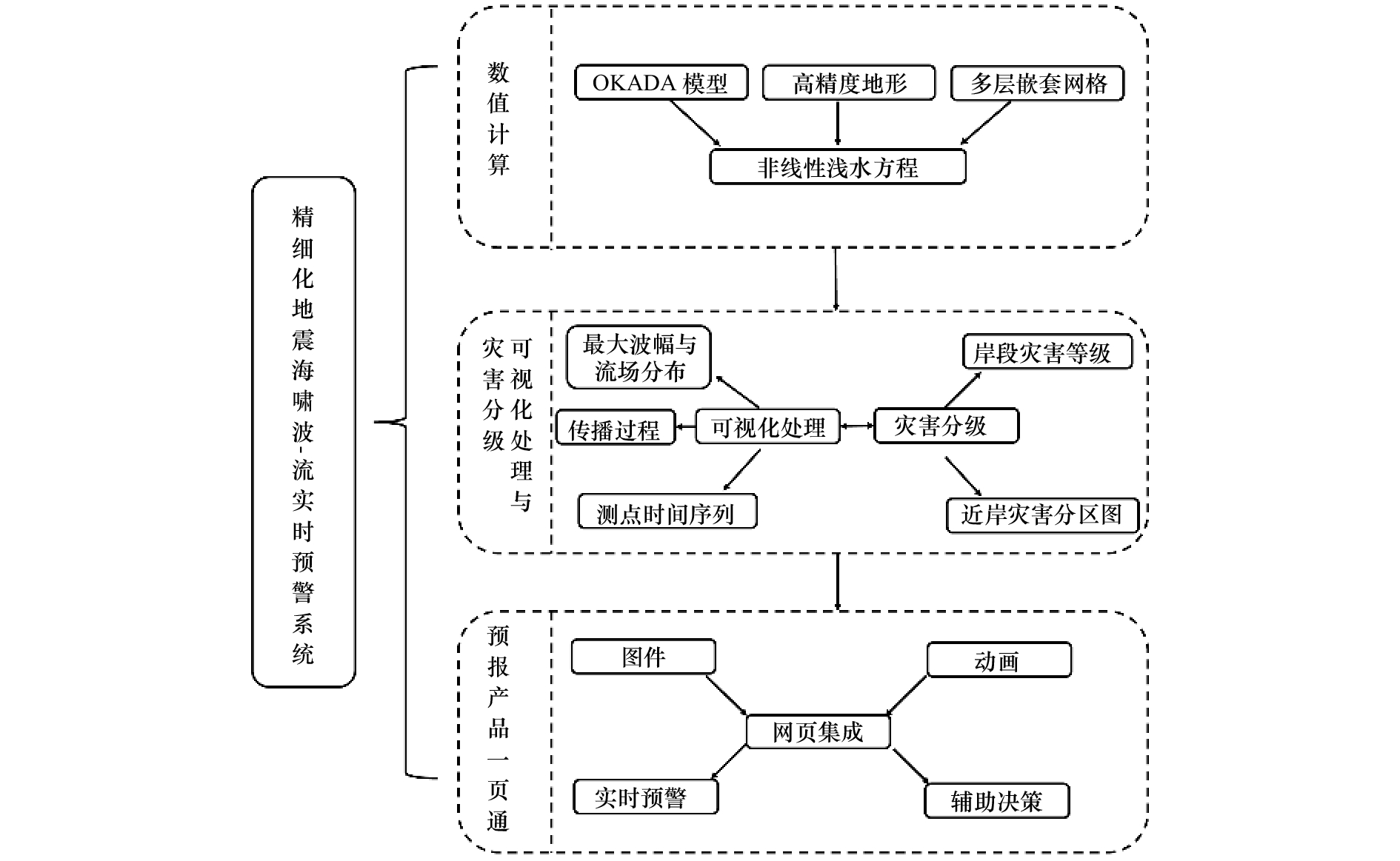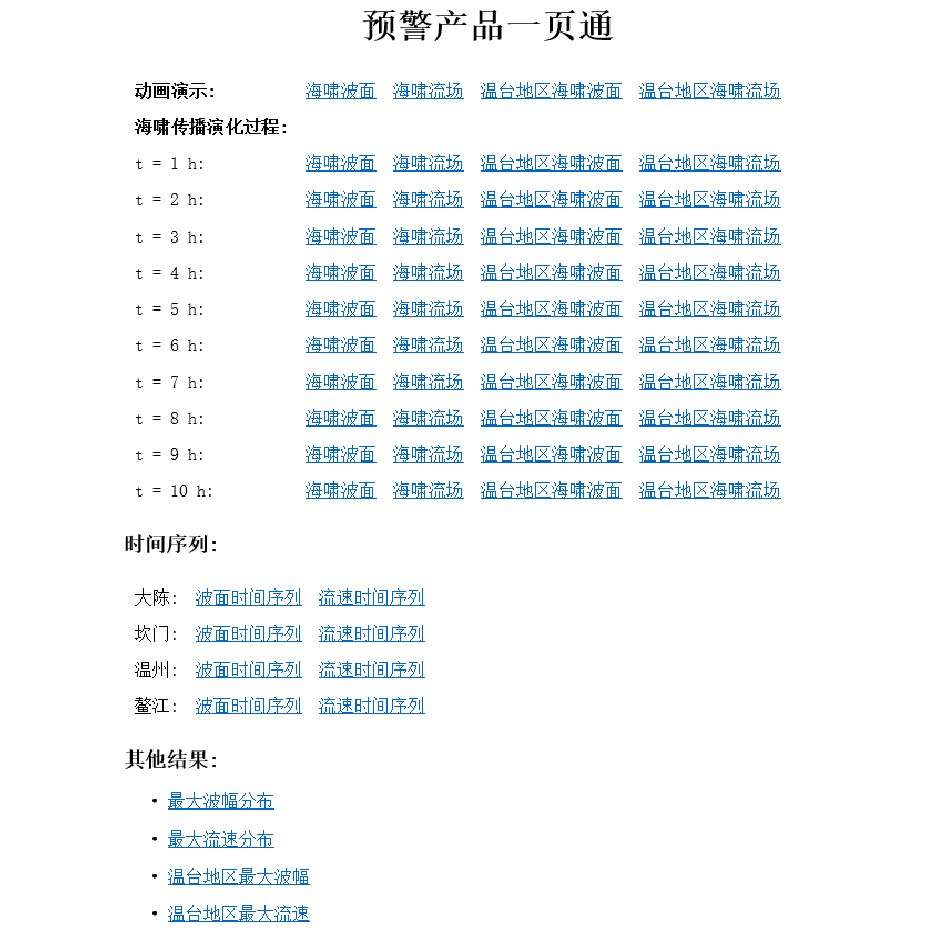Study and application of the refined tsunami real time warning system including tsunamigenic wave and current
-
摘要: 基于Okada模型和非线性浅水波模型,结合高精度多层嵌套网格针对我国浙江沿海的温州和台州地区建立了越洋–近海–局部的精细化地震海啸波流实时预警系统,近岸的分辨率为900 m。该预警系统包括了并行化的数值计算模块,基于Python 2D绘图库的计算结果可视化处理模块,以及通过Python语言将所有经过数值计算的图形与动画产品集成在一个网页上的产品集成模块。一旦地震发生,该系统可根据地震的震源参数信息在10 min内完成数值计算、可视化处理,以及产品集成。选取2011年日本东北9.0级地震海啸结合实测数值对该系统进行模拟验证,进一步应用该系统模拟计算了日本南海海槽和琉球海沟潜在极端海啸的影响规律。结果表明,该预警系统可有效地提高地震海啸实时预警的时效性和准确度,为海啸的预警、减灾,以及辅助决策提供科学依据。Abstract: Based on the Okada model, nonlinear shallow water equation, and nested grid with high resolution, a real-time tsunami warning system of transoceanic-offshore-local is built for Wenzhou and Taizhou’s coastal region of Zhejiang Province. The grid resolution of the refined layer is 900 m. The tsunami warning system includes parallel numerical calculation module, visualization module based on Python 2D library (matplotlib), and product integration module which integrates all numerical graphical products on a web page by Python. Once an earthquake occurs, the system could complete the numerical calculation, visualization processing and graphic product integration within 10 minutes. Firstly, the system has been validated by the 2011 Japan tsunami with the magnitude of Mw 9.0. Then, the extreme potential tsunami from Nankai Trough and Okinawa Trough is simulated by the system in terms of tsunami amplitude and currents. The results show that the tsunami warning system can improve the efficiency and accuracy of tsunami early warning in the coastal region, and provide a scientific basis for tsunami early warning, disaster reduction and decision supporting.
-
Key words:
- earthquake tsunami /
- tsunami warning system /
- refined forecast /
- numerical simulation
-
表 1 海啸灾害风险等级
Tab. 1 Risk level of tsunami hazard
等级 最大波幅/m 最大流速/m·s–1 Ⅳ(蓝色) H≤0.3 V≤0.5 Ⅲ(黄色) 0.3<H≤1.0 0.5<V≤1.0 Ⅱ(橙色) 1.0<H≤3.0 1.0<V≤3.0 Ⅰ(红色) H≥3.0 V≥3.0 表 2 计算网格配置
Tab. 2 Grid resolution
第一层/
分辨率/(′)第二层/
分辨率/(′)第三层/
分辨率/(′)网格数 计算时间/s 网格1 2 1 0.25 138万 4 378 网格2 4 2 0.5 34万 581 网格3 4 2 1 30万 490 -
[1] Løvholt F, Bungum H, Harbitz C B, et al. Earthquake related tsunami hazard along the western coast of Thailand[J]. Natural Hazards and Earth System Sciences, 2006, 6(6): 979−997. doi: 10.5194/nhess-6-979-2006 [2] Tanioka Y, Yudhicara, Kususose T, et al. Rupture process of the 2004 great Sumatra-Andaman earthquake estimated from tsunami waveforms[J]. Earth Planets and Space, 2006, 58(2): 203−209. doi: 10.1186/BF03353379 [3] Mori N, Takahashi T, Yasuda T, et al. Survey of 2011 Tohoku earthquake tsunami inundation and run-up[J]. Geophysical Research Letters, 2011, 38(7): L00G14. [4] 王培涛, 于福江, 赵联大, 等. 2011年3月11日日本地震海啸越洋传播及对中国影响的数值分析[J]. 地球物理学报, 2012, 55(9): 3088−3096. doi: 10.6038/j.issn.0001-5733.2012.09.026Wang Peitao, Yu Fujiang, Zhao Lianda, et al. Numerical analysis of tsunami propagating generated by the Japan Mw9.0 earthquake on Mar.11 in 2011 and its impact on China coasts[J]. Chinese Journal of Geophysics, 2012, 55(9): 3088−3096. doi: 10.6038/j.issn.0001-5733.2012.09.026 [5] Ren Zhiyuan, Wang Benlong, Fan Tingting, et al. Numerical analysis of impacts of 2011 Japan Tohoku tsunami on China coast[J]. Journal of Hydrodynamics, Ser. B, 2013, 25(4): 580−590. doi: 10.1016/S1001-6058(11)60399-6 [6] 任智源, 原野, 赵联大, 等. 2016年全球地震海啸监测预警与数值模拟研究[J]. 海洋科学, 2017, 41(6): 98−110. doi: 10.11759/hykx20170214002Ren Zhiyuan, Yuan Ye, Zhao Lianda, et al. Monitoring, early warning and numerical study of global tsunamis in 2016[J]. Marine Sciences, 2017, 41(6): 98−110. doi: 10.11759/hykx20170214002 [7] 任智源. 南海海啸数值模拟研究[D]. 上海: 上海交通大学, 2015.Ren Zhiyuan. Numerical simulation of tsunami in South China Sea[D]. Shanghai: Shanghai Jiao Tong University, 2015. [8] Qiu Qiang, Li Linlin, Hsu Ya-Ju, et al. Revised earthquake sources along Manila trench for tsunami hazard assessment in the South China Sea[J]. Natural Hazards and Earth System Sciences, 2019, 19(7): 1565−1583. [9] Liu P L F, Wang Xiaoming, Salisbury A J. Tsunami hazard and early warning system in South China Sea[J]. Journal of Asian Earth Sciences, 2009, 36(1): 2−12. doi: 10.1016/j.jseaes.2008.12.010 [10] Ren Zhiyuan, Liu Hua, Wang Benlong, et al. An investigation on multi-buoy inversion method for Tsunami Warning System in South China Sea[J]. Journal of Earthquake and Tsunami, 2014, 8(3): 1440004. doi: 10.1142/S1793431114400041 [11] Wei Yong, Chamberlin C, Titov V V, et al. Modeling of the 2011 Japan tsunami: lessons for near-field forecast[J]. Pure and Applied Geophysics, 2013, 170(6/8): 1309−1331. [12] Ren Zhiyuan, Yuan Ye, Wang Peitao, et al. The September 16, 2015 Mw8.3 Illapel, Chile Earthquake: characteristics of tsunami wave from near-field to far-field[J]. Acta Oceanologica Sinica, 2017, 36(5): 73−82. doi: 10.1007/s13131-017-1005-3 [13] Hou Jingming, Li Xiaojuan, Yuan Ye, et al. Tsunami hazard assessment along the Chinese mainland coast from earthquakes in the Taiwan region[J]. Natural Hazards, 2016, 81(2): 1269−1281. doi: 10.1007/s11069-015-2133-8 [14] Hou Jingming, Li Xiaojuan, Yuan Ye, et al. Scenario-based tsunami evacuation analysis: a case study of Haimen Town, Taizhou, China[J]. Journal of Earthquake and Tsunami, 2017, 11(3): 1750008. doi: 10.1142/S1793431117500087 [15] Fritz H M, Phillips D A, Okayasu A, et al. The 2011 Japan tsunami current velocity measurements from survivor videos at Kesennuma Bay using LiDAR[J]. Geophysical Research Letters, 2012, 39(7): L00G23. [16] Lynett P J, Borrero J, Son S, et al. Assessment of the tsunami-induced current hazard[J]. Geophysical Research Letters, 2014, 41(6): 2048−2055. doi: 10.1002/2013GL058680 [17] Arcos M E M, LeVeque R J. Validating velocities in the GeoClaw tsunami model using observations near Hawaii from the 2011 Tohoku tsunami[J]. Pure and Applied Geophysics, 2015, 172(3/4): 849−867. [18] 王培涛, 闪迪, 王岗, 等. 日本东北Mw9.0地震海啸在港池及邻近区域诱发的涡流危险性计算与评估分析[J]. 地球物理学报, 2016, 59(11): 4162−4177. doi: 10.6038/cjg20161119Wang Peitao, Shan Di, Wang Gang, et al. Modelling and assessment of tsunami-induced vortex flows hazards from the 2011 Mw9.0 Tohoku-oki earthquake in harbors and adjacent area[J]. Chinese Journal of Geophysics, 2016, 59(11): 4162−4177. doi: 10.6038/cjg20161119 [19] Ren Zhiyuan, Zhao Xi, Wang Benlong, et al. Characteristics of wave amplitude and currents in South China Sea induced by a virtual extreme tsunami[J]. Journal of Hydrodynamics, 2017, 29(3): 377−392. doi: 10.1016/S1001-6058(16)60747-3 [20] 王培涛, 于福江, 刘秋兴, 等. 福建沿海精细化台风风暴潮集合数值预报技术研究及应用[J]. 海洋预报, 2010, 27(5): 7−15. doi: 10.3969/j.issn.1003-0239.2010.05.002Wang Peitao, Yu Fujiang, Liu Qiuxing, et al. Study of refined ensemble numerical typhoon surge forecast technology for Fujian coast[J]. Marine Forecasts, 2010, 27(5): 7−15. doi: 10.3969/j.issn.1003-0239.2010.05.002 [21] 刘秋兴, 董剑希, 于福江, 等. 覆盖中国沿海地区的精细化台风风暴潮模型的研究及适用[J]. 海洋学报, 2014, 36(11): 30−37. doi: 10.3969/j.issn.0253-4193.2014.11.004Liu Qiuxing, Dong Jianxi, Yu Fujiang, et al. A high-resolution typhoon storm surge forecast model covering the whole China’s coastal areas and its application[J]. Haiyang Xuebao, 2014, 36(11): 30−37. doi: 10.3969/j.issn.0253-4193.2014.11.004 [22] 罗锋, 盛建明, 潘锡山, 等. 江苏沿海精细化风暴潮模式研究与应用[J]. 南京大学学报: 自然科学, 2014, 50(5): 687−694.Luo Feng, Sheng Jianming, Pan Xishan, et al. Studies and applications of refined storm surge model for Jiangsu coast[J]. Journal of Nanjing University: Natural Sciences, 2014, 50(5): 687−694. [23] 刘秋兴, 李明杰, 吴玮, 等. 温州洞头中心渔港精细化浪潮耦合数值预报系统研究[J]. 海洋预报, 2015, 32(6): 10−18. doi: 10.11737/j.issn.1003-0239.2015.06.002Liu Qiuxing, Li Mingjie, Wu Wei, et al. Studies and applications of coupled wave and storm surge numerical forecast system in Dongtou fishing port[J]. Marine Forecasts, 2015, 32(6): 10−18. doi: 10.11737/j.issn.1003-0239.2015.06.002 [24] 冯芒, 张文静, 李岩, 等. 台湾海峡及近岸区域精细化海浪数值预报系统[J]. 海洋预报, 2013, 30(2): 42−48. doi: 10.11737/j.issn.1003-0239.2013.02.007Feng Mang, Zhang Wenjing, Li Yan, et al. The study of fine-scale precision wave forecasting system in the Taiwan Strait[J]. Marine Forecasts, 2013, 30(2): 42−48. doi: 10.11737/j.issn.1003-0239.2013.02.007 [25] 潘锡山, 盛建明, 韩雪, 等. 江苏辐射沙脊群海域海浪精细化预报模型研究[J]. 淮海工学院学报: 自然科学版, 2017, 26(3): 85−92.Pan Xishan, Sheng Jianming, Han Xue, et al. Fine forecast model on the waves over the radial submarine sand ridges of Jiangsu[J]. Journal of Huaihai Institute of Technology: Natural Science Edition, 2017, 26(3): 85−92. [26] Steketee J A. On Volterra’s dislocations in a semi-infinite elastic medium[J]. Canadian Journal of Physics, 1958, 36(2): 192−205. doi: 10.1139/p58-024 [27] Okada Y. Surface deformation due to shear and tensile faults in a half-space[J]. Bulletin of the Seismological Society of America, 1985, 75(4): 1135−1154. [28] Okada Y. Internal deformation due to shear and tensile faults in a half-space[J]. Bulletin of the Seismological Society of America, 1992, 82(2): 1018−1040. [29] LeVeque R J, George D L, Berger M J. Tsunami modelling with adaptively refined finite volume methods[J]. Acta Numerica, 2011, 20: 211−289. doi: 10.1017/S0962492911000043 [30] 温瑞智, 任叶飞, 李小军. 日本Mw9.0级地震海啸数值模拟与启示[J]. 国际地震动态, 2011(4): 22−27. doi: 10.3969/j.issn.0235-4975.2011.04.006Wen Ruizhi, Ren Yefei, Li Xiaojun. The tsunami simulation for off the Pacific coast of Tohoku earthquake and disaster mitigation in China[J]. Recent Developments in World Seismology, 2011(4): 22−27. doi: 10.3969/j.issn.0235-4975.2011.04.006 [31] Shao Guangfu, Li Xiangyu, Ji Chen, et al. Focal mechanism and slip history of the 2011 Mw9.1 off the Pacific coast of Tohoku Earthquake, constrained with teleseismic body and surface waves[J]. Earth, Planets and Space, 2011, 63(7): 9. [32] Furumura T, Imai K, Maeda T. A revised tsunami source model for the 1707 Hoei earthquake and simulation of tsunami inundation of Ryujin Lake, Kyushu, Japan[J]. Journal of Geophysical Research: Solid Earth, 2011, 116(B2): B02308. [33] Kim K O, Jung K T, Choi B H. Propagation of a tsunami wave generated by an earthquake in the Nankai Trough onto the South Korean coast[J]. Journal of Coastal Research, 2013, 65(S1): 278−283. [34] Yamada Y, Masui R, Tsuji T. Characteristics of a tsunamigenic megasplay fault in the Nankai Trough[J]. Geophysical Research Letters, 2013, 40(17): 4594−4598. doi: 10.1002/grl.50888 [35] 温燕林, 赵文舟, 李伟, 等. 日本南海海槽发生罕遇地震情况下我国华东沿海的海啸危险性研究[J]. 地震学报, 2014, 36(4): 651−661. doi: 10.3969/j.issn.0253-3782.2014.04.011Wen Yanlin, Zhao Wenzhou, Li Wei, et al. Research on the potential tsunami hazard in East China coast under rare earthquake occurred in Nankai Trough, Japan[J]. Acta Seismologica Sinica, 2014, 36(4): 651−661. doi: 10.3969/j.issn.0253-3782.2014.04.011 [36] 毛献忠, 祝倩, Wei Yong. 浙江沿海潜在区域地震海啸风险分析[J]. 海洋学报, 2015, 37(3): 37−45. doi: 10.3969/j.issn.0253-4193.2015.03.004Mao Xianzhong, Zhu Qian, Wei Yong. Risk analysis of potential regional earthquake tsunami on the coast of Zhejiang Province[J]. Haiyang Xuebao, 2015, 37(3): 37−45. doi: 10.3969/j.issn.0253-4193.2015.03.004 [37] 黄强, 景惠敏, 胡培. 日本南海海沟潜在地震海啸对中国东部沿海影响的数值模拟研究[J]. 海洋科学进展, 2018, 36(2): 206−215. doi: 10.3969/j.issn.1671-6647.2018.02.006Huang Qiang, Jing Huimin, Hu Pei. Numerical study on the impact of potential earthquake along the Nankai Trough on eastern coastal area of China[J]. Advances in Marine Science, 2018, 36(2): 206−215. doi: 10.3969/j.issn.1671-6647.2018.02.006 [38] Zhao Xi, Liu Hua, Wang Benlong. Evolvement of tsunami waves on the continental shelves with gentle slope in the China seas[J]. Theoretical and Applied Mechanics Letters, 2013, 3(3): 032005. doi: 10.1063/2.1303205 [39] Zhao Xi, Liu Hua, Wang Benlong. Scenarios of local tsunamis in the China Seas by Boussinesq model[J]. China Ocean Engineering, 2014, 28(3): 303−316. doi: 10.1007/s13344-014-0025-4 [40] 林法玲. “3.11”日本地震海啸及南海和琉球群岛假想地震海啸对福建近海影响的数值模拟[J]. 台湾海峡, 2012, 31(4): 565−570. doi: 10.3969/J.ISSN.1000-8160.2012.04.017Lin Faling. Numerical simulation of the effect of the “3.11” Japan earthquake tsunami and the hypothetical earthquake tsunami at South China Sea and the Ryukyu Islands on Fujian offshore area[J]. Journal of Oceanography in Taiwan Strait, 2012, 31(4): 565−570. doi: 10.3969/J.ISSN.1000-8160.2012.04.017 [41] 温燕林, 于海英, 朱艾斓, 等. 设定琉球海沟发生罕遇地震评估我国东南沿海地区的海啸风险[J]. 地震工程学报, 2016, 38(2): 285−291, 317. doi: 10.3969/j.issn.1000-0844.2016.02.0285Wen Yanlin, Yu Haiying, Zhu Ailan, et al. Numerical simulation of risk in the southeast coastal region of China owing to a rare earthquake-induced tsunami in the Ryukyu Trench[J]. China Earthquake Engineering Journal, 2016, 38(2): 285−291, 317. doi: 10.3969/j.issn.1000-0844.2016.02.0285 -





 下载:
下载:














